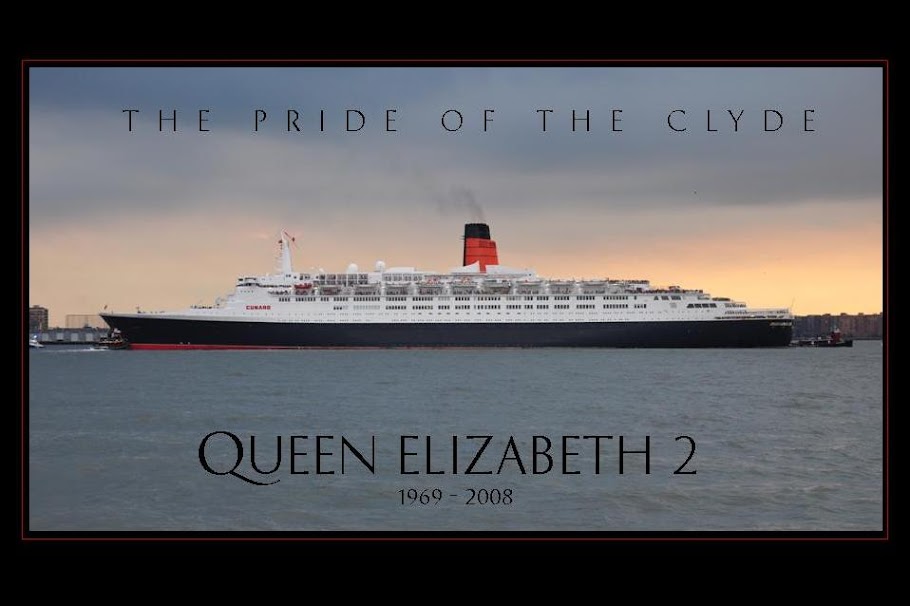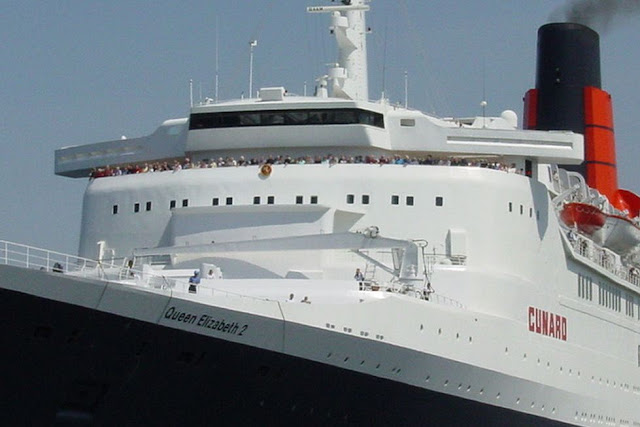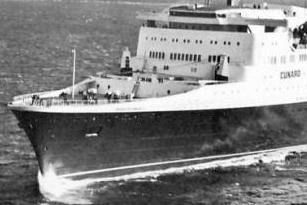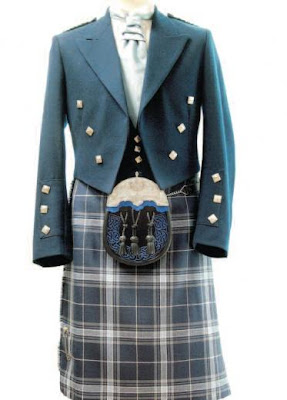26 February, 2011
Bridge Design Evolution of the Queens
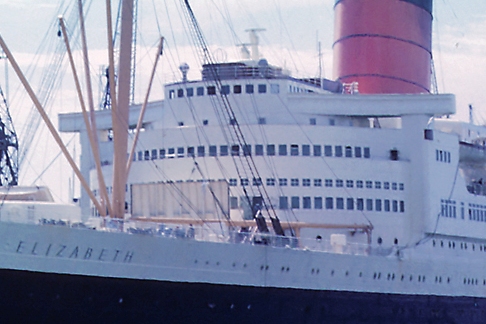 For this excercise, I am deliberately leaving out and discussion on the new Queen Elizabeth. In my opinion, there is no design evolution or connection with the previous Queens save for a near carbon copy of the QE2 foremast and a rather untidy rendition of QE2's iconic funnel. Check back here for a future post on QE's funnel design.
For this excercise, I am deliberately leaving out and discussion on the new Queen Elizabeth. In my opinion, there is no design evolution or connection with the previous Queens save for a near carbon copy of the QE2 foremast and a rather untidy rendition of QE2's iconic funnel. Check back here for a future post on QE's funnel design.Let's compare the original Queen Elizabeth bridge and forward superstructure design with that of Queen Elizabeth 2. The similarities are striking when one compares photos taken at similar angles of the two ships. In retrospect, I now find the QE2 design more evolutionary than I had once thought. The enclosed bridge, while present on the original Elizabeth, gets updated with a modern, futuristic flare on QE2, with the added feature of the forward raked windscreen. Let us also not forget that the original QE2 windows were not painted out in black, but were painted out in a tan color. In my opinion, the black accentuates the design and imparts a look that is more modern that the original color scheme. In fact, Stephen Payne recognized this aspect of QE2's design and incorporated it into Queen Mary 2's bridge design, with the raked center portion and blacked out window frames.
The functional open bridge wings are evident in both Elizabeth designs, with the vertical supports still present, but tucked in a bit from the superstructure on QE2. Cleverly, the ships running lights are integrated into these structures on both ships. Both ships also have observations decks located below the bridge area; my favorite exterior place to be I might add. Even the wind deflector device at the face of the open bridge wings is evident on both designs. The forward facing windows became smaller and less in quantity in the QE2 design, but the intent of updating the Queen Elizabeth fenestration pattern is clearly evident, especially when you see what the original designers intended.
The current configuration of QE2, with the later appendage housing an expanded kitchen and resulting plating over of the taller existing forward facing windows on QE2 diminishes the outright comparison of the appearance of the forward superstructure with that of the original Elizabeth. In fact, when I first laid eyes on QE2, I was surprised to see the lack of forward facing windows. I am not alone in that I have never know QE2 without the modifications to the forward superstructure. From these shots above and below of QE2 undergoing sea trials, it is clear that the designers were intent on an evolutionary, yet modern interpretation of the legendary original Queen Elizabeth, proudly built on the Clyde.
25 February, 2011
Pride of the Clyde Tartan
A Google search revealed that there is a registered tartan called the "Pride of the Clyde." I rather like the color combination. In fact, I had experimented with a background color when setting up this blog initially and it looks like I inadvertently got very close to the to the dominant blue color of the tartan. I guess now I need to find a way to integrate this somewhere in the blog.
Developed by John Keogh of Keogh and Savage Gents Outfitters, Ltd. of Greenock, it appears to have been released in 2007. Not much else was to be found online regarding the tartan, but I did find this press release.
A brand new tartan with echoes of the heritage of the river Clyde has recently been introduced by John Keogh of Keogh and Savage in their shop at West Blackhall Street in Greenock.
'As a child I grew up seeing the edges of the shipyards from my window and have tried to reflect this aspect of Inverclyde within the tartan we have produced', said John. The blue stands for the ocean, with the vertical white lines suggesting the Greenwich meridian and the horizontal white the equator. The grey signifies the steel of the ships which went from Greenock to the four corners of the world. There was a time, you know, when 75% of the world's shipping was built on the Clyde. The thin blue lines represent the burner's torches I could see from my window at night while the thin white line represents the arc of the electrical welders at work. Finally, the light blue signifies the sky's horizon.
We have made the Pride of the Clyde tartan kilts with extra pleats to help signify the waves of the Clyde when worn. We have also designed a special sporran to go with the new tartan using an anchor with a celtic cross effect and three ropes and a blue chain arc on the cantle.
Overall I hope wearers will feel that this new tartan is a celebration of the river and will wear it with pride. A number of kilts have already been sold while others are on order and hire arrangements for the new tartan are in place. We have sent material over to North America with the aim of getting the tartan well known there through the various Scottish Associations.
We also hope that the Pride of the Clyde tartan will be suitable and liked by families whose surname does not lead to a specific named tartan. There also may be some interest from a national media company.'
The new tartan is on display in the Keogh and Savage window in West Blackhall Street, Greenock.
From the Scottish Registry of Tartans website the GOvernment of Scotland's official site, http://www.tartanregister.gov.uk/tartanDetails.aspx?ref=3382, below is an enlarged view of the tartan.
Developed by John Keogh of Keogh and Savage Gents Outfitters, Ltd. of Greenock, it appears to have been released in 2007. Not much else was to be found online regarding the tartan, but I did find this press release.
A brand new tartan with echoes of the heritage of the river Clyde has recently been introduced by John Keogh of Keogh and Savage in their shop at West Blackhall Street in Greenock.
'As a child I grew up seeing the edges of the shipyards from my window and have tried to reflect this aspect of Inverclyde within the tartan we have produced', said John. The blue stands for the ocean, with the vertical white lines suggesting the Greenwich meridian and the horizontal white the equator. The grey signifies the steel of the ships which went from Greenock to the four corners of the world. There was a time, you know, when 75% of the world's shipping was built on the Clyde. The thin blue lines represent the burner's torches I could see from my window at night while the thin white line represents the arc of the electrical welders at work. Finally, the light blue signifies the sky's horizon.
We have made the Pride of the Clyde tartan kilts with extra pleats to help signify the waves of the Clyde when worn. We have also designed a special sporran to go with the new tartan using an anchor with a celtic cross effect and three ropes and a blue chain arc on the cantle.
Overall I hope wearers will feel that this new tartan is a celebration of the river and will wear it with pride. A number of kilts have already been sold while others are on order and hire arrangements for the new tartan are in place. We have sent material over to North America with the aim of getting the tartan well known there through the various Scottish Associations.
We also hope that the Pride of the Clyde tartan will be suitable and liked by families whose surname does not lead to a specific named tartan. There also may be some interest from a national media company.'
The new tartan is on display in the Keogh and Savage window in West Blackhall Street, Greenock.
From the Scottish Registry of Tartans website the GOvernment of Scotland's official site, http://www.tartanregister.gov.uk/tartanDetails.aspx?ref=3382, below is an enlarged view of the tartan.
20 February, 2011
DNA of a Liner
Sometimes there is no need or room to improve upon greatness. Take the bow hull form of QE2. At the time of QM2 construction, QE2 had 35 demanding years of handling the Atlantic Crossing schedule under her belt. Stephen Payne, QM2's Naval Architect has admitted that they essentially copied QE2's bow, scaling up the shape with the only modification being the more modern extended bulbous bow below the waterline. As a further nod to QE2, the center portion of the bridge windows are angled forward in the QM2 fully enclosed bridge design and the window frames blacked out similar to QE2's familiar bridge structure. QE2's DNA has successfully been transferred to the new Cunard Flagship, Queen Mary 2.
Unfortunately, the new Queen Elizabeth shares no DNA with QE2. None. Sorry Cunard marketeers. Her lines are not as fine in the bow sections since she has no need to run at speeds customarily associated with the Queens. She and her sistership Queen Victoria are built for cruising. Nothing wrong with that, but it irks me to no end when I hear all the doublespeak about these new ships being liners. Now I was hoping at least they would paint out the window frames black in an attempt to dress up the Vista Class clone a bit more like her predecessor or even change the amount of glass used in the bridge. At least try to make the ship look like one in the family beyond the color scheme and funnel design. I suspect that might have gone a long way in making these designs more unique and as least looking more like the QE2 or QM2. Here's what the Arcadia, the original Queen Victoria looks like with blacked out window frames.
Speaking of the funnel, I wonder out loud if lifting the funnel design with the uplifting airflow scoops off QE2 was really necessary, beyond marketing purposes for these new ships, QM2 excepted. The ships are never going to travel at QE2's speed, nor do any of the other many Vista Class clones have this feature. They apparently have functioned for years without it. In fact, when the first Queen Victoria hull was reassigned to P &O as the Acadia, they left off the scoops of the decidedly QE2 looking funnel. Has anyone complained?
When it was announced the new Elizabeth would be another clone of Queen Victoria, I had hoped for a bit more individuality on the exterior of the newbuild. Instead, we got the same, with a bit more ugliness at the stern with additional cabins added to an already squared off stern. Even then, this was not unique as this had already been done on the HAL Eurodam and several Costa ships.
While I am in this Vista bashing mood, one thing that has bothered me since the Queen Victoria was unveiled is the "fake" sheerline, done in paint to mimick the hullform of another Cunard ship. This division from Federal Grey to White on the hull of the QE/QV design has as unappealing flatness and unnaturalness in an attempt to replicate the shear of QE2's hull, which is further highlighted with the placement of the name on the bow and the unequal amount of white visible below the name. Holland America ships which share the same hull and similar dark hull/white superstructure treat this area different and, in my opinion, in a more pleasing fashion to the eye.
The reality is though, once on board, the exterior lines and proportions become secondary to the amenities and service that the ship provides for your vacation. With that in mind, I am particularly looking forward to a cruise on the new Queen Elizabeth in the future in her updated Art Deco inspired interiors. Perhaps I am just spoiled with the perfectly proportioned QE2, which I could not find a bad angle to photograph her from.
Why do I dwell on the exterior of these ships? As an Architect, I have been trained to design to not only satisfy the program requirements of the end user, but to also impart a sense of beauty to the design which will be experienced by all. Beauty and proportion go hand in hand, but there is also a functional aspect of design that cannot be overlooked. For instance, while Frank Lloyd Wright's Guggenheim Museum in New York City has great sculptural beauty from the exterior, as a museum to view art, it has its shortcomings with its interior ramp design.
Great design is timeless and is comprised of many layers of allure as one of the partners of the firm I work at often opine that we, as designers, should be striving to achieve. Satisfying and appealing to us on many levels over time, good design will become cherished. Like certain buildings, ships such as Queen Mary and Queen Elizabeth 2 have become cherished. Decorating styles will change, but the backbone and layout of the building, or ship for that matter, must be sound. QE2 was lavishly designed in every detail and proportion, smartly laid out, and stoutly built by proud Scots. I think the results speak for themselves.
19 February, 2011
Stephen Payne's Clever Nod to the Past
Although it has been over a month now since we left Queen Mary 2 in New York City, she is still revealing wonderful little secrets. Uploading and archiving the several thousand photographs taken on the trip has been a daunting task, still not fully complete. While performing some touching up on the above photo, I had the photo zoomed in detail and noticed something that completely escaped me while onboard.
Stephen Payne, Queen Mary 2's Naval Architect, had inserted a subtle reference to the former Queens in the railing projection at the stern of the ship. Queen Mary and Queen Elizabeth, along with most other ships of their vintage, had rear observation wings or decks that extended out beyond the ship to aid in docking maneuvers. Maybe there is a proper name for this feature, but I could not find one with a Google search. Whatever you want to call it, it was as functional as the extended bridge wings in their day, allowing extended views down the length of the ship. Today, I would venture this rear observation platform has been rendered completely obsolete with all the modern day communication and video devices in use on the ship. Seeing this feature in the photo while sitting back at home at the computer, I thought to myself "if only I had seen it on deck, it would have made for some very interesting shots taken looking down the hull."
From the Wikipedia entry on Queen Mary, here is a cropped view of what Stephen Payne was emulating. In the practice of Architecture, we often borrow from the masters that have proceeded us. We have a fancy description for this practice; precident analysis. We look to the past to see what was done right or wrong by designers facing similar constraints. We do this with the intent not to copy, but to build and improve upon the design if possible while imparting our own style. Here is but one of several subtle and not so subtle examples of this practice being brilliantly applied to the Naval Architecture of Queen Mary 2. I will elaborate on further references to great liners of the past used here in future posts.
Simon Fisher Artwork
 Artist Simon Fisher has done beautiful pencil profile drawings of various Cunard Queens and other significant ships in addition to his other nautical artwork. For instance, I have his excellent print of the two original Queens meeting at see on the Atlantic, purchased onboard QE2 back in 2000. I purchased his profile drawings of the QE2, QM2, and original Queen Elizabeth while onboard QE2 on the final winter crossing in January of 2008.
Artist Simon Fisher has done beautiful pencil profile drawings of various Cunard Queens and other significant ships in addition to his other nautical artwork. For instance, I have his excellent print of the two original Queens meeting at see on the Atlantic, purchased onboard QE2 back in 2000. I purchased his profile drawings of the QE2, QM2, and original Queen Elizabeth while onboard QE2 on the final winter crossing in January of 2008. QE2's profile is particularily impressive, perhaps in no small part to the perfect proportions of the ship the artist had to work with. I stood in the que for well over an hour to have Captain Ian McNaught personalize the artwork with his signature. The artwork is now proudly on display in the house along with the original "Lizzy."
Now here is the Queen Mary 2 pencil drawing of her profile. Unfortunately, there is no way to disguise her bulk and less graceful proportions. Different ships for different times would sum it up.
While onboard QM2, I was careful to avoid spending too much time in the Library Gift Shop, knowing how much of a hit my onboard account took on previous QE2 trips. This time, I was in search of one more Simon Fisher print. Not the new Queen Elizabeth print, which I do not know if he has even produced yet, but the original Queen Mary profile pencil drawing. Fortunately, they had one onboard and that became my single artwork pruchase onboard for this cruise. When I get the print similarily framed, she will be displayed above the QM2 print, thus completing my collection of great Cunard ocean liner profile drawings.
I highly recommend these prints for those with similar interests. Prints are available on Cunard ships and on his website. http://www.simonfishermaritime.com/index.html
Subscribe to:
Posts (Atom)
